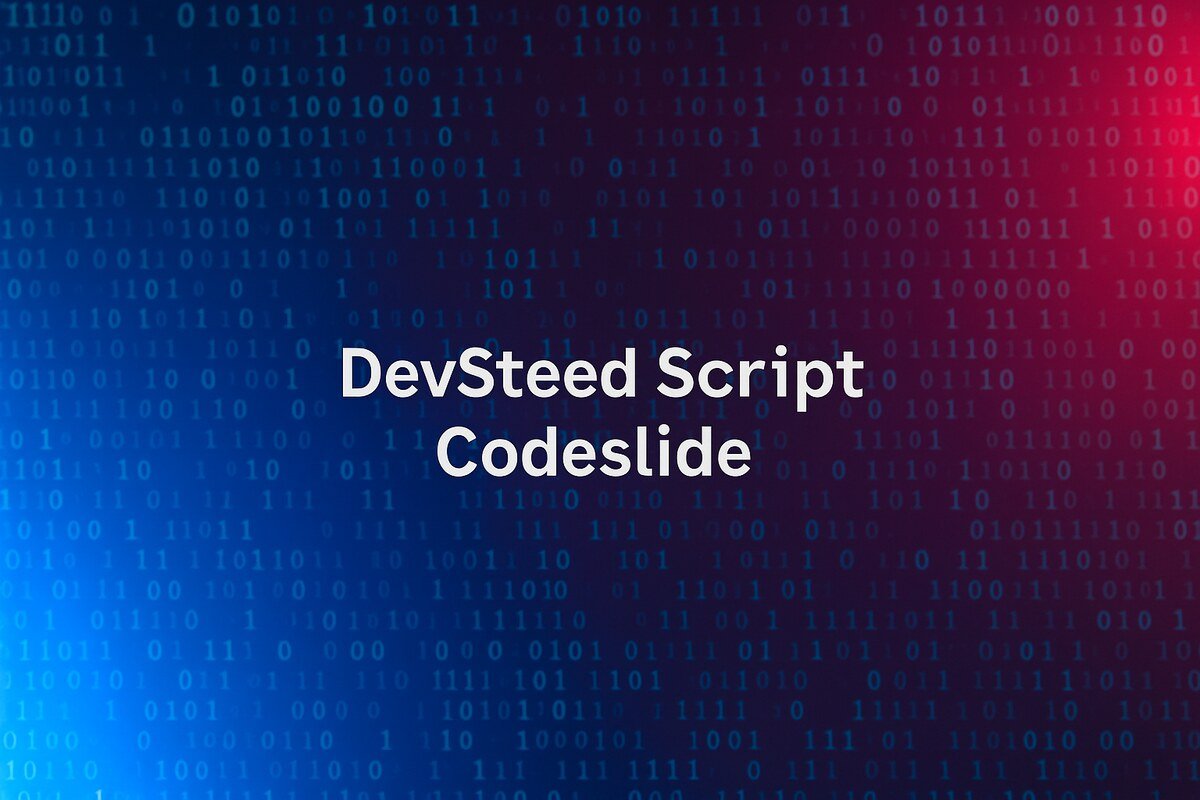If you’ve ever struggled to make your coding workflow quicker and well-organized, you’re not alone. Many developers waste hours repeating the same tasks over and over again that could easily be automated. That’s where DevSteed Script Codeslide comes in. This ultimate guide will walk you through what it is, how to set it up, its most powerful features, and practical ways to use it in real projects. Along the way, I’ll share real tips I’ve used, plus some authoritative resources to back things up.
What is DevSteed Script Codeslide?
Fundamentally, DevSteed Script Codeslide is a scripting tool designed to streamline repetitive coding tasks. Think of it as your own individual assistant that helps you:
- Automate commonly used commands
- Customise your workflow
- Save time on debugging
- Increase team productivity
Many starting developers ask: “Is this just another coding library?” The answer is no. Codeslide is all about productivity. Instead of writing the same function again and again, you can create a script once and use it repeatedly. That’s why it’s gaining popularity among both beginner and experienced developers.
Pro Tip: When I first started using Codeslide, I made a script that automatically created my project folder structure. What used to take me 20 minutes now takes less than 2 minutes.
Key Features of DevSteed Script Codeslide
Here’s what makes DevSteed special:
- Reusable scripts – Automate daily coding tasks.
- Cross-platform support – Works across multiple environments.
- Customizable commands – Tailor the tool to your exact workflow.
- Performance optimization – Run cleaner, faster code.
| Feature | Benefit |
| Automation | Saves hours on repetitive tasks |
| Custom Commands | Personalize based on project needs |
| Optimization | Improves speed and reliability |
| Cross-Platform | Works on Linux, Windows, macOS |
Example: I used a CodeSlide script to automatically rename and organise image resources for a client’s SEO project. What used to take me hours to do was completed in less than 5 minutes.
Another powerful aspect is integration. CodeSlide can be used with project management tools, CI/CD pipelines, and even cloud deployments. This means you can trigger automated actions immediately after pushing code to GitHub or Bitbucket.
Installing and Configuring Codeslide
Installing the DevSteed Script Codeslide is straightforward:
- Download the latest version from the official DevSteed site.
- Install with your package manager (npm, pip, or system installer).
- Add the Codeslide path to your environment variables.
- Run a test script to confirm installation.
Troubleshooting Tip: If your script is not running after setup, recheck your Path settings. I once expended an hour debugging only to find out that I hadn’t added the correct directory to my PATH.
In a team environment, it’s best to set up CodeSlide in a shared environment with version control. This way, all developers will use the same scripts, ensuring consistency across the project.
How to Use DevSteed Script Codeslide
If you’re a beginner, start small.
- Create your first script. Example: a script that prints out “Hello World.”
- Experiment with file handling. Automate creating, editing, or renaming files.
- Try automating commands. Example: a script that runs multiple Git commands with one click.
Personal experience: When I first discovered CodeSlides, I automated a Git workflow. Instead of typing ‘git add‘, ‘git commit –m’, and ‘git push‘ individually, I created a script that performed all three actions automatically. That alone saved me 10-15 minutes a day.
As you develop, try testing with loops, conditional statements and functions in CodeSlide. This way, you can make more smart scripts that change themselves based on input or changing conditions.

Advanced DevSteed Codeslide Tips & Best Practices
Once you’ve learned the basics, you can drive Codeslide further on advanced levels.
- Write modular scripts. Break down large scripts into smaller parts.
- Optimise for speed. Use efficient loops and logic.
- Document your scripts. Add comments so your future self (or teammates) understand them.
- Test regularly. Debugging small chunks is easier than fixing huge scripts.
Callout Box: Quick Tip
If you’re handling text-heavy data, note that the letter frequency in English is dominated by E, T, and A (Norvig, 2013 source). Knowing this can help enhance the description of scripts.
Another clever trick is to use CodeSlide with task schedulers, such as Cron Jobs (Linux) or Task Scheduler (Windows). This way, your scripts will run automatically at scheduled times without requiring any manual intervention.
Read more: 10 Best Server Hosters for Running Your Own Blockchain Network Operations
Practical Applications of DevSteed Codeslide
How developers are truly using Codeslide:
- Web Development: Automating CSS/JS file minification.
- Data Analysis: Cleaning CSVs before importing into Python.
- SEO Projects: Generating sitemaps or fixing broken links.
- Cloud Deployments: Automatically spinning up or shutting down test servers.
Personal example: In an SEO campaign, I used CodeSlide to generate a list of 404 redirects in bulk. It saved me time by eliminating the need to check hundreds of pages manually.
A friend of mine in data analytics built a Codeslide script that preprocessed survey data before loading it into R. This reduced the preprocessing time from hours to minutes.
Productivity Hacks with DevSteed Codeslide
DevSteed isn’t just about automation; it’s about creating smooth workflows.
- Batch Processing: Run multiple scripts in just one go.
- Error Logging: Add logs to detect issues quickly.
- File Automation: Quickly rename or compress large datasets.
Personal Tip: I once had to rename over 1,000 image files for a client. Instead of doing it manually, I created a short Codeslide script that completed the task in under 2 minutes.

Security Considerations When Using Codeslide
Whenever you automate tasks, it is essential to consider security. Keep these things in mind:
- Avoid hardcoding passwords or sensitive data into scripts.
- Always test scripts in a safe environment before positioning them.
- Keep Codeslide updated to fix vulnerabilities.
According to OWASP, automation can lead to significant security risks if it lacks accurate validation. The same applies to Codeslide as well.
Codeslide Integration with Other Tools
One of the best sorts of DevSteed is its compatibility with other platforms:
- Version Control: Activate Codeslide after committing to Git.
- CI/CD Pipelines: Automate build and deployment processes.
- Cloud Services: Integrate with AWS Lambda or Azure Functions.
By merging these tools with Codeslide, you can make a fully automated development environment.
Troubleshooting & Common Issues
Like any tool, Codeslide has specific challenges:
- Error: Script not found → Check your PATH variable.
- Slow performance → Simplify loops, avoid excessive code.
- Surprising results → Debug with logging statements.
If you are working in a team and encounter discrepancies, ensure that everyone is using the same version of DevSteed. Even small version changes can cause big problems.
Latest Codeslide Tech News and Updates
If you’ve been keeping an eye on codeslide tech news, you’ll know that the platform keeps evolving with fresh updates aimed at developers who crave smarter automation. Recent improvements include faster script execution, better integration with cloud APIs, and enhanced compatibility with CI/CD pipelines. Many developers have also highlighted the new debugging console that makes it easier to trace and optimize automation errors in real-time. What’s exciting is that Codeslide’s growing community often shares custom script templates and productivity hacks that anyone can adapt to their workflow. Staying updated with codeslide tech news ensures you never miss the latest features or best practices that could make your development process even smoother.
Conclusion
DevSteed Script Codeslide is not just a tool; it’s your efficiency partner. By learning how to install, customize, and optimize it, you can save your time and focus on what really matters: building and inventing.
Whether you’re a beginner looking to save a few minutes or an experienced developer managing big projects, Codeslide can adjust to your needs. The more you experiment, the more powerful it becomes.
The final message: Don’t just read; set up your first Codeslide script today and realise the difference.
FAQs About DevSteed Script Codeslide
1. What is DevSteed Script Codeslide best for?
Automating repetitive tasks and improving workflows.
2. Is Codeslide beginner-friendly?
Yes, it starts simple but grows with your skills.
3. Can I customize DevSteed Scripts?
Absolutely, customization is one of its strongest features.
4. Does Codeslide work with cloud tools?
Yes, you can integrate it with AWS, GCP, and Azure pipelines.
5. Do I need coding experience to use Codeslide?
Basic scripting knowledge is helpful, but even beginners can learn quickly.
Thanks for visit Techywil











